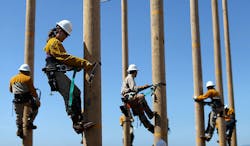The devastation from the hurricanes in Houston, Florida, Puerto Rico and the Virgin Islands brings a renewed focus on one of the biggest challenges to ever face the construction industry: Where are all the skilled tradespeople who will do the work?
Labor shortages have plagued all sorts of contractors throughout the construction industry over the past few years, as in many markets there’s more demand for new homes and commercial construction projects than there are people who can do the work.
Economists at the National Association of Home Builders (NAHB) and Associated General Contractors (AGC) regularly give voice to this problem in their monthly economic summaries. Said Ken Simonson, AGC’s chief economist in a Oct. 2017 press release, “Construction job gains come even as 70% of responding firms reported having a hard time finding qualified craft workers to hire. While many firms’ efforts to increase pay, add benefits and expand the diversity of their workforce appear to be helping, it’s still a challenge for many contractors to keep pace with demand.
“It’s not yet entirely clear how reconstruction work in Texas and Florida following the two recent hurricanes will impact already tight construction labor markets.”
The problem is especially acute in the homebuilding industry, where NAHB data shows that roofers, framers and finish carpenters are scrambling to find workers. Rob Dietz, NAHB’s chief economist and senior VP for economics and housing policy, says that overall the construction industry lost 1.5 million workers during the recession but only brought back approximately 600,000 workers.
In the electrical industry, the National Electrical Contractors Association (NECA) and Independent Electrical Contractors (IEC) are working hard to attract more electricians into their apprenticeship training programs. NECA says although 7,000 electricians join the electrical industry each year, 10,000 retire.
Klein Tools, Lincolnshire, IL, is all-in on attracting more young workers to the electrical field. In addition to writing an article on the subject in EW’s Oct. 2017, Klein Tools President Mark Klein says his company has partnered with the International Brotherhood of Electrical Workers (IBEW), the National Electrical Contractors Association (NECA) and the Electrical Training Alliance to promote comprehensive training. Klein Tools has committed to a $2 million investment over the next five years to provide more tools and education to apprentices in these programs.
Another vocal supporter of the trades is actor John Ratzenberger, perhaps known best for his role as “Cliff” on Cheers. Ratzenberger put a spotlight on the trades several years back through his cable television show “Made in America,” where he profiled various jobs where people work with their hands.
More recently, he made news for donating one million dollars through his non-profit organization, Foundation For America, to bring back shop classes into schools to teach students how to work with their hands and learn a trade. He was also recently selected to serve on the U.S. Department of Labor’s Presidential Task Force on Apprenticeship Expansion.
Along with the labor shortages caused by a busy construction climate is the age-old image problem that the trades have. As shop classes and vocational schools lose favor in many communities, students are nudged toward four-year college classes without being exposed to potential career opportunities in the trades.
I saw this problem years ago while working at the Montgomery County Vo-Tech in Willow Grove, PA, in 1979-1980. I did my master’s thesis on the perception that high school students have of vocational education in general and that school in particular. My research’s key finding was the more students knew about that school or the vocational trades in general, the more positive their perception.
We all need to do our part to get the word out on the career opportunities the trades offer.
About the Author
Jim Lucy
Editor-in-Chief of Electrical Wholesaling and Electrical Marketing
Jim Lucy has been wandering through the electrical market for more than 40 years, most of the time as an editor for Electrical Wholesaling and Electrical Marketing newsletter, and as a contributing writer for EC&M magazine During that time he and the editorial team for the publications have won numerous national awards for their coverage of the electrical business. He showed an early interest in electricity, when as a youth he had an idea for a hot dog cooker. Unfortunately, the first crude prototype malfunctioned and the arc nearly blew him out of his parents' basement.
Before becoming an editor for Electrical Wholesaling and Electrical Marketing, he earned a BA degree in journalism and a MA in communications from Glassboro State College, Glassboro, NJ., which is formerly best known as the site of the 1967 summit meeting between President Lyndon Johnson and Russian Premier Aleksei Nikolayevich Kosygin, and now best known as the New Jersey state college that changed its name in 1992 to Rowan University because of a generous $100 million donation by N.J. zillionaire industrialist Henry Rowan. Jim is a Brooklyn-born Jersey Guy happily transplanted with his wife and three sons in the fertile plains of Kansas for the past 30 years.
